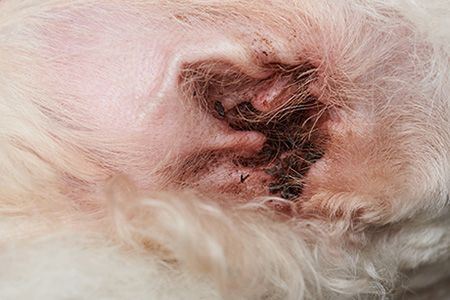The 6 questions every general veterinary practitioner should ask before treating otitis externa
No, there isnt one universally effective therapeutic plan for treating cases of otitis externa in your veterinary patients, but asking yourself these six questions will help you zero in on the best path.

PixieMe/stock.adobe.comYour veterinary team has performed an examination and evaluated cytology slides for the poodle in exam room 3. Just as you suspected, it's a clear-cut case of otitis externa. And now it's treatment time.
How do you narrow down the choices and plan your next steps?
You're in luck. Darin Dell, DVM, DACVD, dvm360 contributor and Fetch dvm360 conference speaker, has developed six questions every practitioner should ask after identifying the cause of otitis externa but before moving forward with treatment.
1. Does the dog have an allergy, and are you treating it now?
You may not treat allergy at the first visit for otitis externa, but you should at least start the conversation about allergy. Allergic diseases are reported as the most common cause of otitis, especially chronic otitis, responsible for 43% of cases.
2. How much debris is in the ear canal?
Knowing this will help you decide what type of cleaner to use and how often. Thick, sticky wax typically calls for a micellar solution or one with squalene. For mucoid exudate, you will probably want to use a TrizEDTA product with chlorhexidine.
3. What is the conformation of the ear canal?
Is it constricted? Cobblestoned? This information also will help you decide what type of ear wash to use and whether to use a topical medication in gel, ointment or liquid form. A more constricted canal requires a wash that is better at dissolving cerumen. Ointments are less likely to travel deep into a constricted or cobblestoned ear canal, so you'll probably want a liquid medication.
4. What type of infection is present?
This will help you pick a topical treatment, with one caveat: You must know what drugs are in the products on your shelf. Infection with rod-shaped bacteria will encourage you to use an ear wash with TrizEDTA. Most rod-shaped bacteria are gram-negative. TrizEDTA damages the gram-negative membrane and forms channels that allow antimicrobials to reach the bacteria.
5. How much edema and erythema are present?
This will tell you what strength of steroid to use. Topical steroid therapy may be sufficient, or you might need oral steroid therapy as well. If the ear canals are completely constricted, then you will definitely need help from an oral steroid. Again, you have to know what ingredients are in the products on your shelf! Common steroid ingredients in otic medications, in order or potency, are prednisolone, betamethasone and mometazone.
6. How much pain and anxiety are present?
This will tell you whether you need to prescribe an additional short-term pain relief/anti-anxiety medication such as tramadol, a nonsteroidal anti-inflammatory drug (e.g. carprofen) or a benzodiazepine (alprazolam). Don't underestimate the pain or anxiety related to ear infection! How many clients have told you their dog runs away when he sees the ear wash bottle or tube of ear ointment? These short-term medications can really help both the dog and the owner.
From Dr. Dell's perspective, unless the patient is aggressive or dangerous, you should try your best to see every tympanic membrane that enters your exam room. And while it might not be easy, anything your veterinary team can do to relieve dogs' itchy, painful ears is a plus.